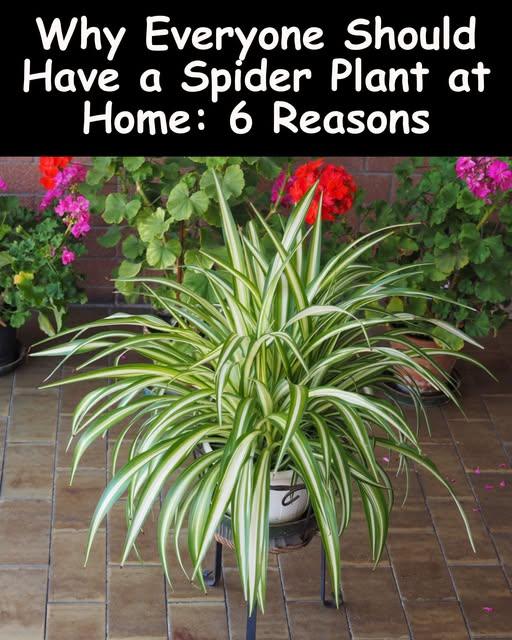4 Amazing Benefits of Spider Plants That Make Them a Must-Have Houseplant
If you’re looking to add greenery to your home with minimal effort and maximum benefit, the spider plant (Chlorophytum comosum) should be at the top of your list. With its graceful arching leaves and compact growth habit, this houseplant offers much more than visual appeal. It’s an excellent choice for both beginners and experienced plant lovers—and especially for those who want a healthier, pet-friendly, and low-maintenance indoor environment.
Let’s explore four compelling reasons why the spider plant continues to earn its place in homes around the world.
1. Spider Plants Purify Indoor Air Naturally
One of the most remarkable benefits of spider plants is their air-purifying power. According to NASA’s famous Clean Air Study, spider plants are effective at removing indoor toxins such as:
- Formaldehyde – commonly released from furniture, flooring, and cleaning products
- Xylene – found in paint, varnishes, and household adhesives
- Carbon monoxide – a potential byproduct of combustion appliances
These pollutants can build up in enclosed spaces, especially in urban homes or apartments with limited ventilation. Spider plants tackle this problem by using photosynthesis to absorb toxins and convert them into clean oxygen.
Place your spider plant in a well-lit spot near a window with gentle airflow to boost this natural air-filtering process. Over time, you’ll notice fresher, cleaner indoor air—no filter replacements or electric purifiers required.
2. Safe for Pets – Non-Toxic to Cats and Dogs
For many plant lovers, one major concern is whether a houseplant might be toxic to pets. With so many popular indoor plants being harmful to cats and dogs, it’s refreshing to know that the spider plant is 100% non-toxic to your furry companions.
According to the ASPCA, spider plants are non-toxic to both cats and dogs, which means you can keep them within reach of curious paws and whiskers without worry.
That said, spider plants can still become a chew toy for cats, who may be attracted to their dangling leaves. While chewing won’t cause poisoning, it might lead to mild tummy upset if your pet munches excessively. To prevent over-nibbling:
- Hang the plant in a basket out of reach
- Spray a pet-safe deterrent on the leaves
- Offer pet-safe grass or catnip as an alternative
But even with occasional leaf tasting, spider plants remain one of the safest houseplant choices for pet households.
3. Boosts Indoor Humidity Levels Naturally
During colder months, indoor air can become dry and harsh, leading to symptoms like:
- Dry skin and cracked lips
- Itchy eyes and throat
- Sinus discomfort and respiratory irritation
- Cracking of wood furniture and flooring
Spider plants help alleviate this problem by increasing humidity through transpiration—a natural process where water is absorbed by the roots and released into the air through the leaves. The result? A gentle, ongoing source of moisture that improves your home’s air quality.
For maximum humidity benefits:
- Group several spider plants together in one area
- Place them in living rooms, bedrooms, or home offices where dry air is most noticeable
- Mist them lightly if you live in an especially arid climate
Without adding a humidifier or altering your heating system, spider plants offer a low-maintenance way to improve comfort during the dry seasons.
4. Adapts Easily to a Variety of Lighting Conditions
Not every home gets perfect sunlight—and that’s exactly where spider plants shine. These plants are remarkably adaptable and can thrive in a wide range of lighting conditions, including:
- Bright, indirect light – their preferred environment
- Partial shade or low light – ideal for offices, bathrooms, or shaded corners
- Filtered sunlight – near east or north-facing windows
Unlike more demanding houseplants, spider plants don’t require constant repositioning or special grow lights. If your space gets natural daylight—even a little—they’ll adjust and flourish with ease.
Too much direct sunlight can scorch the leaves, so avoid placing them in hot, west-facing windows without a sheer curtain. But even if you forget to rotate or move them, these plants stay healthy and vibrant with minimal attention.
Bonus: They’re Easy to Propagate
Once your spider plant matures, you’ll notice baby spiderettes or “pups” growing from the mother plant. These offshoots can be:
- Left to trail for a decorative look
- Snipped and rooted in water or soil to start new plants
- Gifted to friends or used to grow your plant collection
Propagation is incredibly easy, making spider plants a cost-effective way to expand your indoor garden.
Caring for Your Spider Plant – Quick Guide
| Care Factor | Recommendation |
|---|---|
| Watering | Water when the top inch of soil is dry |
| Light | Bright, indirect light preferred; tolerates low light |
| Humidity | Moderate to high; mist occasionally |
| Feeding | Use diluted liquid fertilizer monthly in growing season |
| Potting | Well-draining soil; repot annually if rootbound |
| Propagation | Cut and plant spiderettes in water or soil |
Conclusion: A Perfect Houseplant for Every Lifestyle
With their air-purifying qualities, pet-friendly nature, humidity-boosting abilities, and easy adaptability, spider plants offer so much more than just good looks. Whether you’re new to plant care or a seasoned indoor gardener, this versatile houseplant delivers real, practical benefits—all with minimal maintenance.
Add a spider plant to your home and enjoy a greener, healthier, and more welcoming living space.
